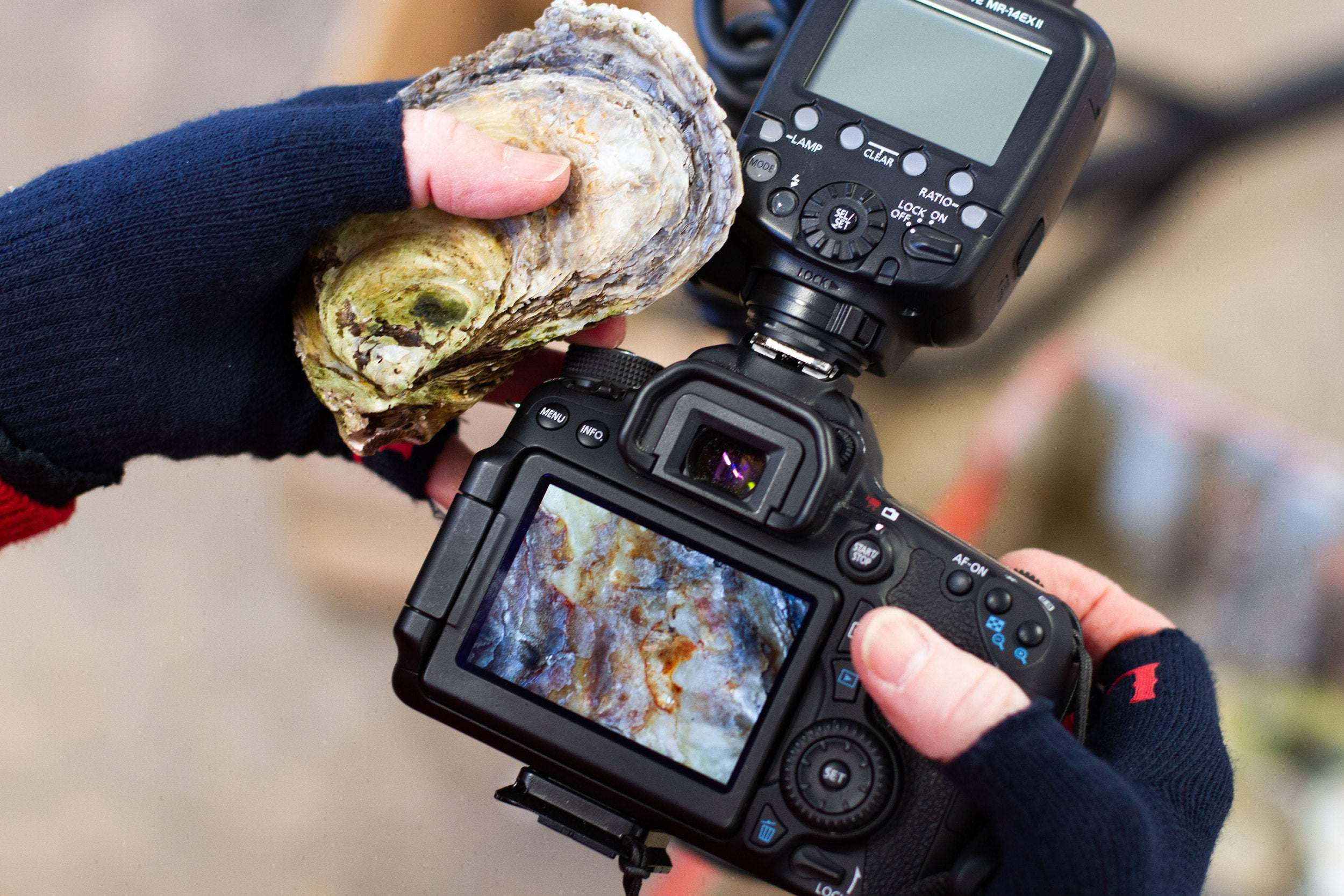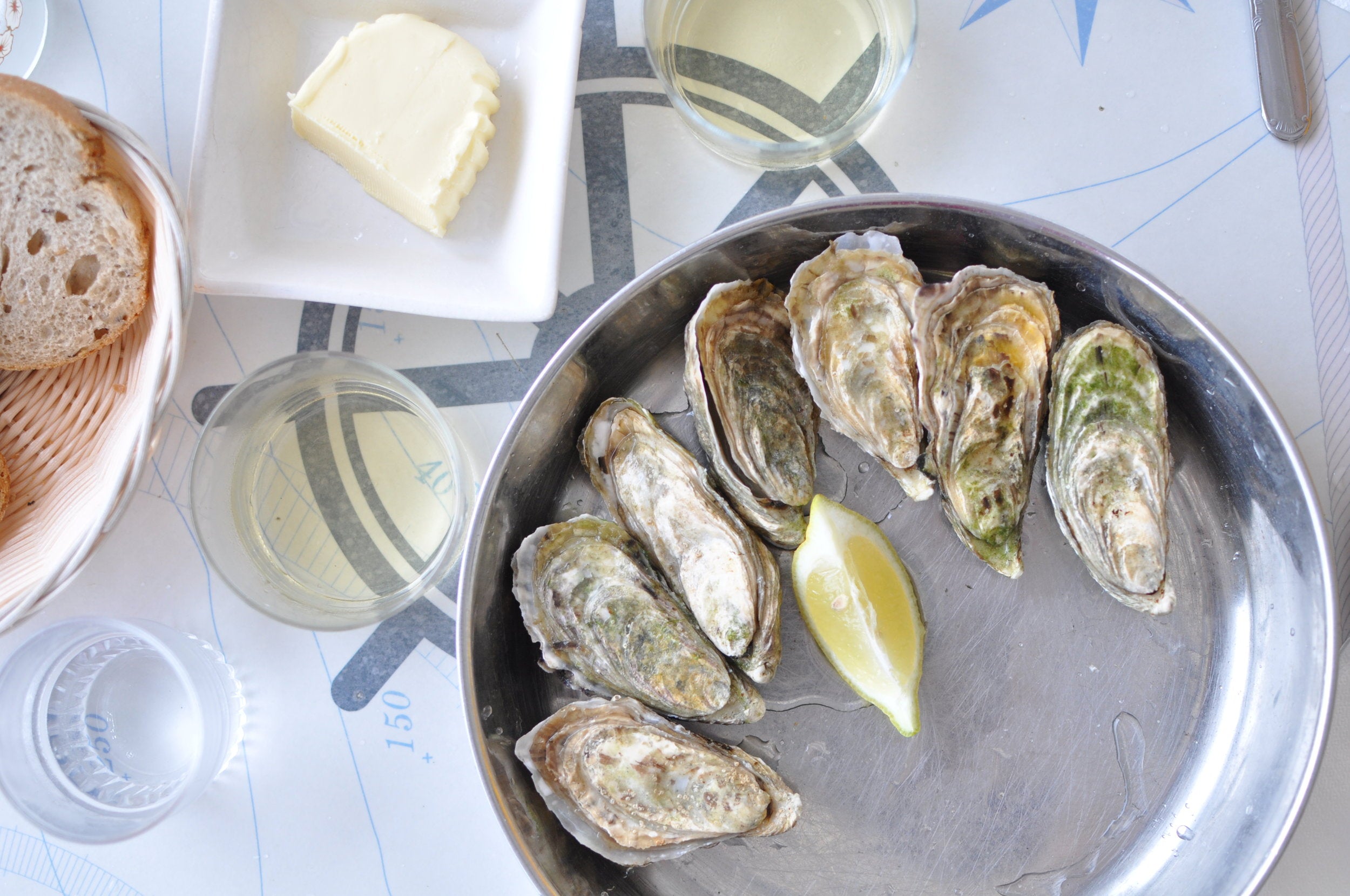La Cabane du Grouin: Île de Ré’s First “Organic” Oyster Farm

Welcome to the western coast of France. It’s a hazy, humid summer morning after rain, and so dewy it’s coating our faces in salty mist. Warwick and I are crunched into a tiny white Fiat, bumbling and bouncing over gravel roads and potholes, amidst a sea of drooping grapevines and marshy fields. There are endless jerks and jiggles and heavy sighs abound as we get used to driving with a stick shift again.
It’s July in Île de Ré, and here we are, two foreigners who speak no French, working out how we found ourselves scouring the earth in hunt for the world’s most precious bivalves. A part of us takes much pride in this endeavor; the other part finds it the most unusual hobby.
As we glanced at the GPS, it was quite a vision. Île de Ré is known for its oyster farms, and it is the most peculiar looking grid. Google Maps had outlined every oyster salt basin, and it was hard to believe there were roads that weaved between them at times.

What the oyster farm water basins look like on the map in Ile de Re!
We pulled up to La Cabane du Grouin, an Île de Ré oyster farm. The hotel concierge team at L’Hôtel de Toiras were flawless in helping with this unique request, months in advance. They even secured a French-English translator to join us and ensure our story was well worth the visit.
As we parked, a Frenchwoman in high spirits approached us with a sweet smile and big wave. This was our translator, Françoise. Françoise came totally prepared - she had studied and printed out aquaculture vocabulary in French and English to ensure that she could relay the conversation correctly. She also knew the farmer very well and was a tour guide on the island, so it took the edge off immediately as we began introductions.

Arriving to La Cabane du Grouin

Working out the translations: Frederic, Me, and Francoise.
Frédéric Voisin emerged from behind a tall stack of oyster cages. He’s middle-aged, tan, lean and his eyes are kind. He welcomed us with laughs and spoke much more English than I offered back in French. Françoise was the perfect intermediary; every translation was turned into something we could smile and chuckle about. When we began, Françoise turned to Frédéric and said, “we’re working together here. I’ll help you and you help me!”

Frederic Voisin, Owner of Voisin Oysters.
Frédéric Voisin’s Story
Frédéric’s great-grandfather was an oyster farmer, but Frederic did not immediately go into the oyster business himself. He studied engineering and moved into development and construction. After years of exposure to the dust and loose particles, his health began to suffer due to skin and nose allergies. In addition to that, he was always on the road and away from home. When it became too much to continue, he turned to a profession that still allowed him to work with his hands, but with an atmosphere that was much more natural.
“I came back to Île de Ré in 2002 when I was 45,” said Frédéric, “and spent a year in training for shellfish farming . Then I had the opportunity to buy this site, but it was not an oyster farm when I bought it. It had been a salt-making farm for over 100 years, so I had to transform all the salt basins for oyster farming. The big difference was creating the channels and pumps for seawater that made the natural flow from one basin to another.”
When Frédéric decided to farm oysters, he was determined to carve out his own path in a very saturated industry on the island. As a man of science and engineering, he began to design his process in a way that honored the island’s ecology. Frédéric’s oysters are the first-ever oyster farm on the island to receive organic certification by the Agence BIO.
Frédéric explained his initial intentions. “As I was looking to grow oysters organically, I asked myself, what is ecology? Where should we incorporate it and what should we do?”

Frederic Voisin, Owner of Voisin Oysters.
What “Organic” Means to Voisin Oysters
There were several areas he focused on in applying organic techniques to oyster farming. The first was water quality of his oyster beds and basins. This was exceptionally important in growing a high quality product.
The second was how he was going to acquire seed. Frédéric walked us over to show us his spat catching cages. “You can buy the oysters from a firm which provides the babies, “ Françoise helped explain from Frédéric’s feedback. “But he takes the baby oysters directly from the sea.”

The spat catchers.
Off the island’s coasts, there are large fish ponds that are like big u-shaped walls. Traditionally, the structures were built by the islanders in the Middle Ages to catch fish. At high tide, the water would go over the walls and the fish would be trapped in the ponds after the tide retracted. Frédéric puts his cages in the ancient pools during spawning to catch the babies on the cages and protect them as they began to grow.
The third important consideration was to keep the entire oyster farming process on the island. After 11 months, baby oysters are transferred to larger cages where the remain for two more years in the sea. After that, they are taken to his 10 hectares of salt basins on the island where they complete their final grow-out, eating as much as possible before market.
Many other large scale oyster farmers are shipping their oysters to places like Brittany for their final grow-out. Frédéric believes that everything should take place in the same ecological environment where they are from. This, he insists, is for the overall health of the oysters.
His saltwater basins are additionally unique in that they pump fresh seawater directly into his channels and basins, which is unlike some other oyster farms that do not have a fresh seawater source.
During our conversation, I mentioned the new buzz word, “Merroir” to Frederic. He didn’t know it. I laughed at the fact that we stole a French concept - we completely made up a word with French flair - and it was his first time hearing it. Editor’s Note: Frédéric did give the nod of approval.

Frederic’s saltwater basins.

The edge of one of the basins.
The Circle of Life
Frédéric’s final organic concept was to create a harmonious process in the grow-out phase that used natural organisms to his advantage.
The answer? Oysters, mud worms and imperial shrimp… All together in the same salt basins.
Frédéric filled his basins with mud worms that buried into the bottoms of the silt and mud and ate the micro-plants that were growing, so that only plankton and algae remained for the oysters to consume.
He decided to also farm imperial shrimp, which are natural carnivores and love eating mud worms. As the shrimp bury through the silt looking for mud worms to eat, the plankton and algae become more suspended in the water, allowing his oysters to more heartily feast on the natural food. As the natural seawater pumps through the basins, the plankton circulates and the oysters enjoy a strong final growth spurt before they’re off to market.

Frederic showing us the various stages of oyster growth.
Frédéric’s production is very small in comparison to other farmers on the island - about 3 metric tonnes per year, whereas many oyster farmers produce about 200 metric tonnes per year.
“I my basins, I only have two oysters and two shrimp per one meter squared. For that, I require quite a bit of land to sustain the production.”

Frederic explains how the oysters, mud worms and shrimp live in harmony.
Those Pesky Eels
As we strolled around the farm, I asked Frédéric about some of his challenges. He mentioned that in order to have natural seawater pumping into his salt basins, he runs into a lot of eels who try to sneak in through the channels at night to feed upon his shrimp. For this, he installed fencing that blocks eels from entering his basins through the pumps. The problem? He has to clean out all the eels who get stuck in his piping - especially after large storms and water surges.
Working with nature has its ups and downs, Frédéric shared, and the heavy labor still takes a toll on his health. But the most rewarding part of it is being considered as the first organic oyster farm on the island. He mentioned that there are a massive amount of applications for BIO certification on the island now, and he is very happy about that, but also proud that he made it in first.
Sensory Perfection
“Would you like to stay and try them? To taste?” said Frédéric.
“There’s no way we would have left without it,” I joked.

La Cabane - where we enjoyed our fruits du mer.
After our tour, we nestled back onto the patio with Françoise for a feast. For the oyster tourist, this is it - this is the view that inspires you. You’re on the farm, next to their small cabane, and everything is serene. You’re seeing the beauty with your eyes, smelling the dewy, salty air, listening to the soft breeze and the rustling of sea grass. You’re touching the fine grooves of the oyster shell and admiring the textures. You are fully engaged in every sensory feeling, which makes this gastronomic experience so honest, cathartic, and memorable.

First round: Conch and Snail

Voisin oysters on half shell.
The oysters were uncompromisingly perfect. The immediate taste was a deep brine, but the hues of the algae surfaced on the gills of the oysters and produced robust flavors of the natural plankton from the lush and marshy surroundings. They finished entirely clean and refreshing. Every ounce of hard work in Frédéric’s process was realized and honored in each bite.
Our meal continued for about an hour over a bottle of local white wine, which was very neutral to taste and balanced the oyster’s bold flavors well. Frederic brought us some of his very best - from raw half shell, to a plate of conch and snails, and his delicious organically grown imperial shrimp. Then he surprised us with more oysters topped with Herring roe wakame and yuzu, as well as cooked oysters covered in a buttery cream sauce. Our eyes rolled back in delight at the new and unsuspecting flavors.

Voisin oysters with Herring roe and Japanese seaweed
In these moments we knew that chasing oysters and their growers around the world - this most unusual hobby - was a gift we hope will never end.
Thank you to La Cabane du Grouin, Frédéric, Françoise, and L’Hôtel de Toiras for one of our most memorable experiences yet.
If you would like to get in touch with Frédéric Voisin, you can email him at voisinfrederic@wanadoo.fr. Françoise offers other private guided tours of the island and surrounding areas. She can be reached at visiter17@gmail.com.

Serenity of La Cabane du Grouin



